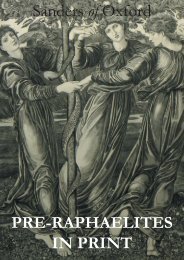Create successful ePaper yourself
Turn your PDF publications into a flip-book with our unique Google optimized e-Paper software.
Dimensions: 9 1/4 x 7 1/4 inches<br />
Code: AD32<br />
Price [Framed]: £320<br />
A rare naturalistic outdoor study <strong>of</strong> a senior maiko, or possibly a debuting geisha, wearing<br />
lacquered okubo [high clogs]. Their distinctive sound, resonating throughout the floating<br />
world, entered the Japanese language as the onomatopoeia koppori or pokkuri.<br />
51. Anonymous Photographer, possibly Kusakabe Kimbei (1841-1934)<br />
On Snowing [Geisha in a Two-passenger Jinrikisha]<br />
Date [Western]: ca. 1880-5<br />
Date [Japanese]: Meiji period<br />
Method: Hand-tinted albumen print<br />
Dimensions: 7 3/4 x 10 1/4 inches [Image]<br />
Code: SOX<br />
Price [Framed]: £170<br />
The jinrikisha [lit. man-powered vehicle] or rickshaw first appeared in Tôkyô in 1870. An<br />
invention variously ascribed to Jonathan Goble, an American Baptist missionary, and to<br />
Izumi Yosuke, Suzuki Tokujiro, and Takayama Kosuke, the group <strong>of</strong> enterprising Japanese<br />
townsmen who obtained the first manufacturing license, the jinrikisha quickly replaced the<br />
kago [palanquin] as the transportation <strong>of</strong> choice for the urban masses <strong>of</strong> the Meiji period.<br />
According to a contemporary report in the Shinbun Zasshi newspaper, its rise in popularity<br />
was such that by 1872, only two years after the first passengers were gingerly stepping into<br />
the early prototypes, over 40, 000 were plying their trade in the capital’s streets.<br />
From its inception, it was constructed in one- and two-passenger versions, the latter swiftly<br />
becoming identified with trysts and romantic intimacy, inspiring popular songs such as<br />
Ainori Horokake (‘Beneath a Hood for Two’) and Hoppeta Ottsuke (‘Cheek Pressed to<br />
Cheek’). As such, it became a mainstay <strong>of</strong> early photographer’s studios: here, two young<br />
geisha pose amidst a carefully constructed winter scene.<br />
52. Felice Beato (ca. 1825-ca.1908)<br />
Japonais dans son intérier [Geisha holding an ebony kiseru [pipe], surrounded by the<br />
symbols <strong>of</strong> her art ~ shamisen, koto and tea kettle]<br />
Date [Western]: ca.1880-1883<br />
Date [Japanese]: ca. Meiji 13-16<br />
Method: Hand-tinted albumen silver photograph<br />
Studio Location: Yokohama<br />
Dimensions: 10 x 7 3/4 inches [Image]<br />
Code: AD1<br />
Price [Mounted]: £480<br />
Felice Beato was arguably the most important foreign figure working in the field <strong>of</strong> Japanese<br />
photography in the late nineteenth century. One <strong>of</strong> the originators <strong>of</strong> photojournalism, he<br />
travelled to India in 1857, taking what are retrospectively considered to be the definitive<br />
images <strong>of</strong> the Indian Mutiny, and then to East Asia in 1860, becoming the first Western<br />
photographer to work in China, as he followed and recorded the British army during the<br />
Second Opium War. Previously he had worked as an assistant to James Robertson, whose<br />
body <strong>of</strong> work in the Crimea, to which Beato contributed, is generally defined as the first<br />
distinct example <strong>of</strong> objective war photojournalism.<br />
Beato was probably born in Corfu, then a Venetian territory, but at some point he and his<br />
brother Antonio (or Antoine) Beato (ca.1830-ca.1903), both became British citizens. This<br />
was a period when Britain welcomed political exiles and many Italian nationalists, such as<br />
the Rossetti family, were living and working in London. Antonio Beato was also a keen<br />
photographer and the two brothers worked together on a number <strong>of</strong> occasions, signing their<br />
collaborative works Felice Antonio Beato; later problematizing the identification <strong>of</strong>












